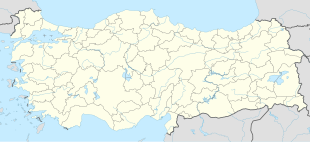Saint Bartholomew Monastery
| Saint Bartholomew Monastery | |
|---|---|

The monastery of Saint Bartholomew in 1913
|
|
| Basic information | |
| Location | Albayrak,Van Province, Turkey |
| Geographic coordinates | 38°09′00″N 44°12′47″E / 38.149942°N 44.212925°ECoordinates: 38°09′00″N 44°12′47″E / 38.149942°N 44.212925°E |
| Affiliation | Armenian Apostolic Church |
| Country | Turkey |
| Status | Half-ruined |
| Architectural description | |
| Architectural style | Armenian |
| Completed | 13th century (monastery) |
Saint Bartholomew Monastery (Armenian: Սուրբ Բարդուղիմեոսի վանք, Surb Barduğimeosi vank' ; Western Armenian: Surp Part'uğimeosi vank' ) was a medieval Armenian monastery in the historic province of Vaspurakan, 23 km north-east from the town of Başkale, in present-day Turkey's Van Province, near the Iranian border. The monastery was built on the traditional site of martyrdom of Bartholomew the Apostle, who is reputed to have brought Christianity to Armenia in the first century. Along with Thaddeus the Apostle, Bartholomew is considered the patron saint of the Armenian Apostolic Church. It was a prominent pilgrimage site prior to the Armenian Genocide. Today, it is heavily ruined and the dome entirely gone.
According to tradition the monastery was founded by the Arsacid King Sanatruk in the first century on the tomb of Bartholomew the Apostle, who healed him from leprosy. Other sources say it was founded in the 4th or 6th century. However, the monastery is first mentioned in the 13th century, when it was most likely built. Hampikian wrote that it was the hall that was founded in the 13th century in front of the entrance of an preexisting church.Murad Hasratyan suggested that the main church was built in the 13th century on the foundations of an older basilica.
It rose to prominence in the 14th century. In 1316 father Hakob participated in the Church Council of Adana (). Pope John XXII in 1321 suggested him in a letter to adopt the Roman Rite. A gospel was replicated at the monastery in 1339 and Historical Compilation by Vardan Areveltsi in 1398. A gospel was reproduced at the monastery by the scribe Margar in 1487 and 1490. The monastery was one of the major monasteries of medieval Armenia.
...
Wikipedia

